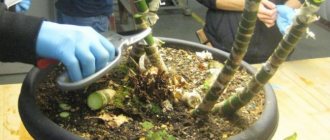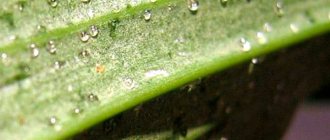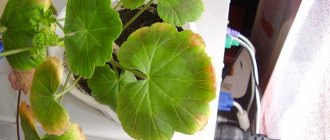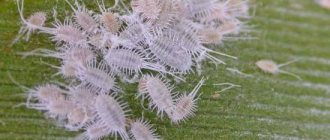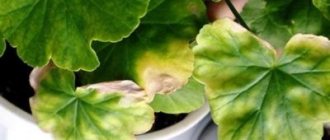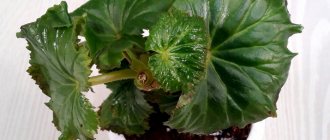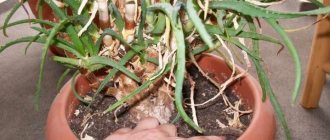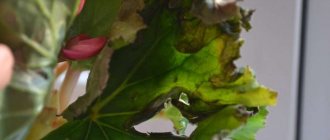Dieffenbachia is a very common indoor ornamental plant and is part of the Araceae family. The trunk of the plant is strong and fleshy, and the leaves are soft, oval-shaped, containing a characteristic light pattern on a dark green background, although they can be rich green depending on the variety. In total, the plant has a little more than forty varieties. They differ in shape, leaf structure and root system.
Despite the fact that this plant is characterized by good and rapid growth, it has increased sensitivity to some external factors, which leads to its illness, loss of decorativeness, and sometimes even death. Here we will describe in detail situations in which the appearance of the plant suffers. Most often these are problems with leaves.
Direct sunlight
When direct rays of the sun hit the leaves of Dieffenbachia, yellow-brown burns are formed, which lead to yellowing and drying of the entire leaf.
It should be remembered that Dieffenbachia should not be kept in the sun, but in partial shade..
In summer, the plant should be placed on a south-eastern window, where the sun's rays will hit it only in the morning.
Here the lighting will be sufficient for good growth, but without direct sun. If this is not possible and Dieffenbachia grows on a south-facing window, it must be shaded to avoid burns.
In winter, the flower requires fairly intense lighting. It is better to move it to the most illuminated windowsill. Winter sun rays will not harm the flower; you should not be afraid of direct sun during the cold season.
Be careful - Dieffenbachia!
Despite its attractiveness, the sweet tropical beauty is a poisonous plant. The juice secreted by the plant causes minor damage to the skin. But if it gets on the mucous tissue of the mouth or eye, a burn occurs. In rare cases, complete intoxication of the body may occur, which manifests itself as follows:
- swelling of the oral tissues and lips;
- copious amounts of saliva;
- rapid breathing;
- vomit;
- diarrhea;
- temperature increase;
- tearfulness.
First aid for Dieffenbachia burns, and treatment consists of simple steps. First you need to rinse the affected area of skin with running water. If there is pain, apply a lidocaine solution to the burn. If the juice gets on the eyeball, wash the affected eye with running water for about 20 minutes. Then use Levomycetin drops or furatsilin solution to prevent infection.
Burns caused by Dieffenbachia juice in the mouth are removed by rinsing. Clearly expressed pain can be quenched with a solution of novocaine (0.5%). After these steps, it is recommended to drink a glass of cold milk or water. In any case, when a problem arises, it is important not to waste time, but to act.
Description of the plant - main characteristics
Dieffenbachia has a fleshy and strong stem on which variegated and large leaves are located. This plant has a distinctive feature in the form of an interesting pattern on the surface of the leaf blades. They have stripes with a blurred outline and small spots of light color.
Dieffenbachia grows well at home, and with quality care it can grow up to 2 meters in height in 3 years. This plant is often used in interior decoration; it is used not only in apartments, but also in public organizations.
Important! You should be aware that the juice of Dieffenbachia tissue is poisonous and can cause burns to the mucous membranes or skin. Contact with the poisonous part is most dangerous for children and animals.
There are 40 varieties of this plant in the world and each of them has distinctive features in color and size:
- Dieffenbachia charming grows up to one and a half meters, its leaf blades are up to 28 cm in length;
- dieffenbachia spotted is distinguished by a dense stem and oval leaf blades with variegated colors;
- Dieffenbachia Leopolda is a low-growing variety with a green stem with blue-red spots, leaves about 30 cm long;
- Dieffenbachia Baumann is distinguished by large leaf blades that grow up to 75 cm in length, they are colored green and covered with light spots;
- Dieffenbachia Oersted has cone-shaped leaves in emerald color with a white stripe in the middle.
All available varieties of Dieffenbachia are beautiful and take root well at home. In order for them to feel comfortable, it is important to create suitable conditions that are close to natural.
Why the edges and middle of the leaves turn yellow: reasons
Dieffenbachia gets sick quickly and unexpectedly.
It would seem that everything is in order, but a certain moment comes, and your health suddenly disappears. This is the difficulty of the disease - to detect it, you will have to conduct many experiments to find out the exact source of the problem. The only case when you shouldn’t worry is when a flower has recently appeared in the house. Perhaps you just recently bought it, and it is already showing signs of illness. The fact is that a flower, like a person, experiences “stress” in a new team . Namely due to changes in living conditions.
This will be especially noticeable if you bought Dieffenbachia in a retail store. There, the flowers are “fed” with stimulants, and after you bring it home, it stops receiving the dose.
But there may still be danger. You should check the flower for the presence of the following elements :
The following explains why the tips and central part of the leaves of a flower may turn yellow if left for a long time at home.
Leaves dry out due to time
Your flower is already more than a year old and you have noticed that from time to time its lower leaves turn yellow and dry out. There is no problem here - this is a feature of Dieffenbachia. Over time, it becomes similar to a false palm due to its long stem and bushy top.
To maintain an acceptable appearance of the plant, it is enough to do the following:
But even if the lower leaves still turn yellow and dry out, don’t worry, this is how it should be.
Lack or excess of light
If all this time you thought that Dieffenbachia needed more light, forget it. An overdose of sun, in particular from direct rays, is as harmful as a deficiency. Plus, in addition to the yellowness of the leaves, a flower overheated by the sun gets burned . The edges of the leaves will become dry and begin to curl, and brown spots may appear in the center of the leaf. The plant gradually dies.
To avoid this, in the summer months the pot with Dieffenbachia is moved away from the south side. She feels most comfortable in the southeast and southwest directions. Are the windows facing north? Great, there the plant will be saturated with soft diffused light.
In winter, another problem arises - lack of light. The flower will be pale and elongated. The stem seems to be reaching towards the light. This can be corrected by providing the plant with an excellent source of artificial light. In the morning and evening the lights are turned on over the Dieffenbachia . It is important that it is “cold”. The procedure should last 2-3 hours.
Temperature instability
Pay attention to where your flower is located during the off-season.
If, for example, in winter you decide to ventilate the room, and there is a flower in a draft, prepare for the fact that the leaves of the flower will soon begin to turn yellow. The problem becomes worse if you combine a cold spell with a flower transplant . A rotting process may occur. And what’s most “funny” is that it is impossible to discover that the roots are sick without digging up the entire plant. But still there are characteristic signs. The leaves may become limp and therefore turn yellow. It will be quite difficult to correct the situation.
Dry air
The causes of this problem may be the operation of heaters and batteries. And in summer you don’t even need any “amplifiers” - the air is always stuffy. Here, you can help the flower by observing a regular watering regime.
In winter the situation is different. It is aggravated by different heating systems.
Violation of the watering regime
You shouldn't go from one extreme to another.
Less watering is bad. A lot of watering is the same. Moreover, if you overdo it, the plant will begin to rot. At first it will just be yellowing and discoloration of the leaves at the edges. After some time, the whole flower will become like this. To determine the ideal option, there are some instructions. Dip your finger into the ground and note for yourself at what depth the soil is dry. Let’s say the finger fits into the phalanx without difficulty and doesn’t stick to the ground—the plant needs to be watered.
Small “living space”
Dieffenbachia may begin to protest in the form of yellowing leaves if there is not enough space for it . The roots of the plant had grown so much that they occupied the entire pot. You can verify this by conducting a small experiment.
Near the bottom of the flower, grab the stem. If a dense tangle of roots appears from the pot, the problem is really in the pot. If the ground rises, then everything is in order.
The soil is not suitable
Dieffenbachia does not tolerate being in heavy soil . The soil should be as follows:
Little or much food
Failure to apply fertilizers in a timely manner significantly affects the yellowness of the leaves.
And it is better to underfeed than to overfeed, since it is not easy to remove excess amounts of fertilizer from the ground. At the very least, this will take a lot of time. In addition, while the soil is being cleaned, Dieffenbachia is poisoned. Well, torture yourself and the flower - replant it in new soil. There are some principles in applying fertilizers :
Disease
If you suspect a disease, it is better to immediately transfer the flower to new soil , checking the roots and treating them with a fungicide.
Impact of insect pests
Yellow spots have appeared on the flower, something sticky remains on your fingers when you touch it, brown plaques, cobwebs - your flower has been attacked by insects.
How to help Dieffenbachia:
It's time to learn how to care for yellowing Dieffenbachia.
Causes of yellowing of Dieffenbachia leaves
Dieffenbachia quickly reacts to changes in conditions by deteriorating its appearance. Its leaves often turn yellow, and sometimes even experienced gardeners cannot confidently name the reason for this.
Indeed, yellowing of leaves is caused by many factors: very bright lighting, excessive watering, changes in temperature and humidity, attack by pests and some others.
In the article you will learn what to do if the leaves of Dieffenbachia turn yellow, and you will also see the reasons why this happens.
Strong hydration
Excessive moisture leads to fungal diseases of the plant
Excessive soil moisture easily leads to various fungal diseases. When the roots rot, the leaves of the plant first fall down and then begin to turn yellow. Moreover, the plates throughout the plant turn yellow.
In case of rotting, Dieffenbachia needs an emergency transplant and reduced watering , and sometimes this does not help. We have to cut off and root the surviving tops.
To protect the plant from rotting, it is necessary to strictly adhere to its watering regime. You can’t overwater the flower, but you shouldn’t overdry the earthen ball either, as this can cause the death of the plant. Keeping the soil moist but not wet is quite simple. Watering is carried out only after the top layer of soil in the pot has dried to a depth of 2-3 cm.
Sometimes plants turn yellow as a result of root rot and with the correct watering regime. This happens when the soil composition is incorrectly selected. The soil for Dieffenbachia should be light. In heavy soils, water stagnation and root rot are possible.
Rules for caring for Dieffenbachia
In order for this wonderful ornamental plant to please its owners with health and beauty, they must provide it with not numerous, but mandatory conditions.
- The permanent location of the bush should be well lit in the cold season, and in summer it is better to place the flower near a window, but not directly in front of it, since open sunlight is dangerous for its leaves. Staying in the shade for a long time leads to loss of brightness and color.
- The optimal air temperature for Dieffenbachia in summer is within twenty-five degrees Celsius. But provided that it is well moistened, the plant tolerates thirty-degree heat quite well. Winter temperatures should not be below sixteen degrees Celsius. Moreover, the plant does not tolerate drafts and sudden temperature fluctuations. Therefore, if the room is often ventilated, then Dieffenbachia should either be moved to another room or placed in a “secluded” corner of the room, inaccessible to fresh air flows.
- The main requirement for Dieffenbachia is watering. The entire growing season should be accompanied by abundant watering, so that the soil in the pot is moistened all the time, but does not stagnate. A sign of overwatering is the appearance of brown and yellow leaves on the plant. Experienced gardeners recommend using this technique when growing Dieffenbachia: once a month, leave the earthen lump of the plant in water for fifteen minutes, allowing the excess water to drain off after the procedure. It is very important to use settled water (preferably purified) at room temperature for irrigation. If the water is too cold, this will also soon affect the condition of the leaves of the indoor flower; they will curl and turn yellow.
- Air humidity is another important point when growing Dieffenbachia at home. Since this is a tropical plant, it simply needs regular spraying. During the summer, the plant needs a weekly shower. It will not only moisturize the leaves well, but also rid them of dust. When the ambient temperature reaches twenty degrees, it is recommended to place containers of water around the plant, or place the bush on moistened gravel.
Why do Dieffenbachia drops form on the leaves?
This unusual phenomenon is called Guttation (gutta - drop), and consists in the release of droplet liquid by the leaves of the plant in order to free it from excess amounts of water and various mineral salts.
In addition to too abundant and frequent irrigation measures, guttation can increase under conditions of decreased atmospheric pressure. Along with other aroids, Dieffenbachia sap is poisonous , so it is not recommended to touch the droplets actively released on the surface of the leaf blades. Over time, they dry out on their own.
Common diseases
One of the most common factors causing yellowing of leaves are fungal, bacterial, and viral infections of the plant. Usually they are quite difficult to identify, so we will dwell in more detail on the description of the most dangerous ones.
Fungal
Fungal pathologies include the following ailments.
Fungal diseases usually spread through damaged leaves and moisture. In order to avoid such infections, special attention must be paid to preventive measures:
It is possible to cure fungal infections in the early stages - to do this, all damaged parts of the plant must be removed, the flower treated with systemic fungicides and placed in new soil, it is also advisable to change the pot or disinfect the old one.
Bacterial
The main disease is bacteriosis. With it, the leaves turn yellow, watery spots with pronounced edges appear on them. Over time, they begin to turn brown and change color to brown. Unfortunately, this plant cannot be saved - there are currently no methods for treating bacteriosis.
Viral
Typically, leaves change color due to such a dangerous viral disease as bronzing. First, round yellowish spots appear on the leaf blades, then the affected areas die off, but the leaves themselves remain on the branches. The plant stops developing, and viruses are quickly transmitted from the diseased Dieffenbachia to neighboring indoor flowers. Viruses cannot be cured; the infected plant must be destroyed.
In conclusion, it should be noted that yellowing of foliage does not always indicate a serious problem. If a few lower leaves dry out and the phenomenon does not spread further, this means that the natural process of aging of Dieffenbachia is taking place and there is no need to worry about the fate of your green pet.
To learn why Dieffenbachia turns yellow, watch the following video.
Low air humidity
With insufficient watering and low humidity, Dieffenbachia leaves begin to turn yellow from below. First the tips turn yellow, then the entire leaf blade. Such plates dry out and fall off over time. This is often accompanied by loss of color and lightening of the upper leaves.
Often in a city apartment it is difficult to create the necessary air humidity for Dieffenbachia . In summer, the room is quite hot and dry; in winter, during the heating season, the air is dried out greatly by heating radiators. Therefore, for many inexperienced gardeners, Dieffenbachia is a long bare trunk with several leaves at the top.
For a plant to maintain its beauty, regular watering and spraying is not enough. It is useful to place it in a tray with a damp substrate: expanded clay, sand or moss. The substrate will humidify the air near the plant and also help preserve its green mass.
Reduced temperature and draft
Dieffenbachia is a heat-loving tropical plant. At low temperatures, Dieffenbachia can drop all its leaves (especially if the temperature drops sharply).
The leaves turn yellow very quickly throughout the plant and fall off, except for the very top ones.
The reaction of Dieffenbachia to a draft is drying out and yellowing of the tips of the leaves. If such symptoms occur, you need to move the plant away from opening windows, otherwise it may turn completely yellow and then lose all its foliage.
Dieffenbachia can also react when kept in an air-conditioned room. If you are near an air conditioner under a stream of cold air, it will certainly shed its leaves and lose its beautiful appearance.
You cannot keep this plant not only under air conditioning, but even away from it, because it does not tolerate temperature changes in such a room very well.
How to save Dieffenbachia
If the reason for the falling of yellow leaves lies in age, then the plant that is too bare and elongated is rejuvenated. For this:
- The crown is cut off with 2-3 nodes below the last leaves and placed in water or rooted in a peat-sand mixture.
- The long stem is cut into equal sections - 5-6 cm, placed in the same mixture, or moistened sphagnum, dropped right there in a pot or placed in water. Each cutting segment will give roots and sprout.
- The remaining stump will produce a lateral shoot - the Dieffenbachia will rejuvenate and continue active growth.
Having discovered signs or at least hints of rot, the grower does not hesitate. Only the promptness of the measures taken will save the plant:
- Dieffenbachia is removed from the ground. Inspect the roots.
- If soggy, blackened roots with spots or the smell of rot are found, all damaged areas are cut out.
- The above-ground part is also subject to careful inspection. The affected parts are cut out.
- After the “surgical intervention,” the plant is treated with a fungicide, and then the sections are covered with crushed coal.
- After drying the plant, it is transplanted into new soil. The container is also taken new.
- After transplantation, keep in deep shade for 3-4 days and monitor the condition.
Important ! This ornamental leaf plant is poisonous. Such work is carried out with gloves, preventing juice from getting on the skin and eyes.
Transplantation and propagation of Dieffenbachia
Dieffenbachia must be replanted in the spring, after the plant's winter rest period. For replanting, you should choose a pot that will be larger than the previous one. When replanting, it is advisable to dig the Dieffenbachia stem deeper, then the plant will give new leaves. The larger the Dieffenbachia pot, the larger its leaves will be. This type of plant takes up all the space provided to it very quickly. However, you should not increase the width and depth of the pot by more than two fingers at a time.
Reproduction of Dieffenbachia is a long process, it takes from several weeks to six months. Reproduction of Dieffenbachia is possible both by cuttings and pieces of stem or seeds. To propagate Dieffenbachia, you need to root cuttings from the top of the plant stem in water or sand. The soil should be slightly damp; it is advisable to cover the Dieffenbachia with film or a glass jar on top. The optimal temperature for plant propagation is 21-23 degrees. To speed up the propagation process, you can use rooting preparations: Kornevin, Zircon, Heteroauxin, Ecogel.
When propagating Dieffenbachia in water, the cuttings can be transplanted when the roots reach 3-4 cm in length. Propagating Dieffenbachia by seeds is a very long and labor-intensive process that will require experience, time and resources. For beginning flower growers, it may be too complicated and unfruitful. However, if you decide to choose this method, you will need to pollinate the plant yourself. After successful pollination, reddish-orange poisonous berries ripen on the Dieffenbachia trunk. Their ripening can be determined by their appearance; the seeds will be ready when the shell of the berries wrinkles. It is advisable to sow Dieffenbachia spotted seeds immediately after harvesting from the plant. It is best to plant them in pre-prepared sphagnum moss.
Spots on Dieffenbachia leaves - flower diseases
Infected soil, pests or a diseased flower can cause the plant to become infected with a viral, bacterial or fungal disease. As a result, the leaves lose their decorative properties, and the bush dies over time.
Viral diseases
Viruses are carried by pests or the plant can become infected from a nearby diseased flower. Most often, Dieffenbachia is affected by the following viral diseases:
1. Viral mosaic is identified by dark green round spots on the leaves that have a light center. Over time, the spots become more and more numerous, and the bush stops growing.
2. Bronzing of leaves is a disease in which ring-shaped or round yellow spots appear on the leaves of Dieffenbachia. The affected leaves do not fall off, but wither.
Viral diseases cannot be cured. The plant should be destroyed, otherwise it will infect other indoor flowers.
Bacterial diseases
The appearance of watery spots on the stem and leaves should alert you. If they have clearly visible boundaries and after some time become brown or brown, then this is bacteriosis. Unfortunately, there is no cure for this bacterial disease. It is transmitted through damage on the stems from one plant to another. A flower affected by bacteriosis soon dies.
Fungal diseases
Poor-quality contaminated soil, water and remains of diseased plant parts can cause fungal diseases to damage Dieffenbichia. The most common include:
1. Leaf spotting. If small brown spots with an orange border appear on the leaves of Dieffenbachia, then most likely this is a fungal disease. Over time, the spots grow and affect the entire leaf blade.
2. Root rot. In this case, a light gray coating appears on the roots, dark spots appear on the root collar, and after a while the leaves droop and turn yellow. As a result, the plant dies. The root rot fungus lives in poor-quality contaminated soil and begins to develop rapidly when the soil moisture is high.
3. Anthractosis. The disease can be recognized by fairly large dark brown spots along the edge and near the edge of the leaf. The spots have a yellowish border. If left untreated, the leaves gradually dry out and die.
In the initial stages, fungal diseases can be eliminated with the help of special fungicidal preparations. If the above-described signs are detected, the bush should be treated according to the instructions with Vitaros or Fundazol.
Dieffenbachia diseases and their treatment
How to help a tropical beauty?
- Dieffenbachia leaves turn yellow, reasons, what to do? Solution to the problem:
- low air humidity. Dieffenbachia, not receiving enough moisture from the air, also begins to turn yellow, so in winter it should be kept away from central heating radiators or buy an air humidifier;
- direct sunlight, there should be enough light;
- excessive watering, Dieffenbachia is moisture-loving and watering should be quite abundant, especially in summer;
It is necessary to check whether the roots of the flower have actually begun to rot. To do this, you need to remove the plant from the pot, inspect the root system, remove rot and affected areas of the root, transplant the flower into another smaller container, observing the planting rules (drainage 1/3 of the pot, 2/3 soil mixed with sand and peat) - low air temperature. Dieffenbachia is a tropical resident, it loves warmth, so the temperature in the room should not fall below 22 degrees;
- drafts, which the flower really does not like, so it is better to keep Dieffenbachia away from the balcony door and windows;
Dieffenbachia dries and its leaves fall off, the tips of the leaves dry and wither, causes and solution to the problem:
- fungal infections (atracnose, leaf spot), fungal spores (leaf spot) can be obtained by the plant with irrigation water; dry brown spots appear along the edges of the leaves, gradually spreading over the entire surface of the leaf, it becomes lethargic and lifeless.
Athracnose is provoked by excessively high temperature in the room, dry air, in some cases, waterlogged soil (excessive watering); to get rid of this problem, it is enough to normalize the temperature and watering regime; the affected leaves can be treated with a regular fungicide to prevent infection of other leaves; - drafts, low air temperatures can also lead to leaves drying out and falling off; to eliminate the Dieffenbachia problem, you need to ensure a comfortable microclimate in the room;
- the plant ages, the lower leaves dry out and fall off, this is a natural process. It is necessary to rejuvenate it by cuttings. To do this, the bare trunk of Dieffenbachia needs to be cut into cuttings, leaving only a small part of the stem in the pot, which will soon give rise to a new shoot and Dieffenbachia will continue to grow;
- the impact of pests, which we will talk about a little later and in more detail.
Dieffenbachia withers, causes and solution to the problem:
- fusarium disease, the causative agents of the disease are in the soil, affect the root system, gradually brown oblong spots appear on the leaves and trunk, and the plant begins to wither.
To combat fusarium, the flower must be transplanted into another pot, after removing rot from the roots and treating the affected areas with a fungicide; - root rot, which appears when the soil is overly fertilized and moistened. Rot first affects the root system, then gradually affects the trunk, the flower withers and dies. It is necessary to replant Dieffenbachia, having previously treated the roots with a fungicide and limit watering;
- overmoistening in combination with low air temperature, in this case it is necessary to provide the plant with a comfortable temperature and limit watering.
Dieffenbachia leaves curl or do not unfold as they grow. Causes and solution to the problem:
- When watering with cold water, it is advisable to leave the water for irrigation for at least 24 hours;
- drafts and low room temperature;
- pest attack.
Dieffenbachia does not grow, causes and solution to the problem:
- viral lesions (bronzing and viral mosaic), usually carried by insects, yellow round spots (bronzing) or a mosaic of spots (viral mosaic) appear on the leaves of the plant, Dieffenbachia withers and stops developing. It is almost impossible to cope with such a problem; the flower must be destroyed;
- there is not enough light. You need to move the flower to a brighter room, but remember that the flower does not tolerate direct sunlight;
- insufficient watering. The soil in the pot should always be slightly damp;
- lack of fertilizers in the soil. The lack of fertilizers, as well as their excess, negatively affects the growth and development of Dieffenbachia; the fertilizer must be used strictly according to the instructions indicated on the packaging;
Dieffenbachia is crying, causes and solution to the problem:
excessive watering. The flower protects itself from excess moisture in the soil; a similar phenomenon can be observed before rain; the plant opens channels for moisture to escape, preparing for an excess of water.
In the photo below you will see the symptoms of the disease in Dieffenbachia:
Pest infestation
When attacked by spider mites, yellow spots first appear on the leaves of the plant, which then cover the entire leaf blade.
This pest is easy to detect on the underside of leaves, which can be completely covered with a thin web. Typically, treatment with special chemicals allows you to quickly destroy the pest.
Already yellowed plates cannot be restored . Over time, they dry out and fall off. But eliminating mistakes in plant care will lead to the growth of young, healthy greenery.
Bush varieties will acquire lush shapes and green coloring. It is better to renew old tall plants that have lost their leaves by cutting off and rooting the tops. After this, the new plants need to create optimal conditions for growth and development.
Features of growing Dieffenbachia (video)
Since the exotic guest is quite capricious, her leaves often turn yellow and dry. This can be caused by both disturbances in the care process and diseases, which are quite common for this particular type of plant. Why do plant leaves turn yellow?
Violation of care rules
Several factors can lead to violation of plant care rules. In the first place is improper watering - it can be either excessively abundant or insufficient. The air in the room where Dieffenbachia is located can be very dry. This also applies to office premises, where the lighting is in most cases artificial, and the flowerpot itself is on the windowsill, where sunlight practically does not penetrate. No matter how strange it may sound, pets may also be involved in violations of plant care . They may chew or scratch the leaves of the flower, but the damage may not be noticeable at first glance. In this way, an infection can be introduced that interferes with the normal development of the plant.
Dieffenbachia diseases and methods of their treatment
Dieffenbachia, like any living creature, can get sick and be affected by infections. Fungal, bacterial and viral diseases can interfere with the normal development of the plant. Leaf spotting, which forms first at the edges of the foliage and then spreads to the entire blade, can be caused by improper room temperature or high humidity. Overwatering and accumulation of liquid in the soil can also To avoid such phenomena, it is necessary not only to reconsider the systematicity of irrigation, but also the water itself that is used for these purposes.
Anthractic disease - with a fungal disease, the stems and leaves are affected by small orange spots, which over time merge into one large lesion, leading to complete drying of the leaf. It occurs for the same reasons as regular spotting. Treatment of affected areas of the plant is carried out by spraying Dieffenbachia with fungicides.
Fusarios is an infectious flower disease that affects the roots and basal part of Dieffenbachia. Long orange spots appear on the affected areas, which lead to drying out and death of the plant. The appearance of such an infection is caused by overdried soil and lack of fertilizers. To cure a tree, you need to remove the roots from the pot, rinse it under water and get rid of the contaminated soil. Then spray the roots several times with preparations containing fungicides and transplant the plant into new soil.
How to deal with Dieffenbachia pests (video)
Root rot can also lead to yellowing and drying of leaves . To do this, as in the previous case, it is necessary to dig out the roots and clean them of infection. If the roots are black and have an unpleasant odor, this is a sure sign of disease. It can be caused by overwatering. To treat Dieffenbachia, you need to clean the infected roots, replant it in a new place, treat the soil with a fungicide and reconsider the watering.
The leaves of the plant may be subject to bacteriosis, during which watery spots with clear boundaries along the edges appear on the affected areas. The development of this disease can be triggered by infection during transplantation or cuttings. To get rid of the infection, you need to spray the plant with preparations containing copper.
Dieffenbachia pests affecting the condition of leaves
Despite the fact that Dieffenbachia is partly a toxic plant, it is also susceptible to attack by pests that damage it and affect the foliar system. The most common parasites include:
Natural causes
Natural causes can also lead to yellowing of Dieffenbachia leaves. In general, this is a natural process that affects older lower leaves. However, when the first spots and dry areas appear on the leaves, there is no need to rush to get rid of them and cut them off at the root. You need to wait until the leaves are completely dry and begin to fall off. Flower growers claim that pruning leaves causes great harm to the plant.
Why does Dieffenbachia turn yellow? Dieffenbachia leaves turn yellow - how to help the plant?
Dieffenbachia is a fairly common houseplant. Caring for it is not difficult. However, gardeners are interested in why Dieffenbachia leaves turn yellow, what to do in this case, how can you help the plant? In this article we will try to answer these questions.
But first you need to find out why the leaves of Dieffenbachia turn yellow, what reasons contribute to the development of this disease. They may be different. Conventionally, experts divide them into three categories: pests, diseases, and improper care.
About precautions
Dieffenbachia is undoubtedly an aesthetically attractive plant. However, one cannot ignore the fact that it can pose a real threat to others if handled carelessly. The poisonous houseplant Dieffenbachia contains substances that cause allergic reactions when directly interacting with the skin or mucous membrane. It leaves burns and ulcers. Dieffenbachia should be kept in places that are difficult for children to reach. Moreover, it is not recommended as a decorative element in preschool institutions.
For animals, contact with the poisonous Dieffenbachia plant is no less dangerous. It has been noticed that cats have an increased interest in it. As in humans, if an animal chews a leaf of a plant, it can both provoke severe poisoning and cause anaphylactic shock.
When in contact with the plant, you should always wear gloves and protect your eyes from possible splashes of poison when pruning.
Why do Dieffenbachia leaves turn yellow? 3 main reasons
Andrey Babitsky, a biologist and experienced specialist in indoor and greenhouse plants, shares useful information about the spectacular and flexible Dieffenbachia.
Dieffenbachia is a genus of tropical evergreen herbaceous plants of the Araceae family, native to South and North America.
Why do Dieffenbachia leaves begin to turn yellow?
The genus includes 66 species, many of which, due to the decorative qualities of their leaves, are used in indoor floriculture. The most common decorative species of Dieffenbachia include D. amoena, D. seguine, D. bausei and others.
Dieffenbachia seguine
